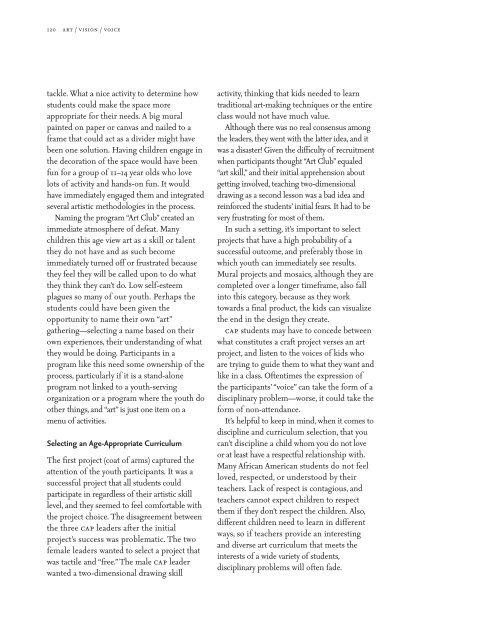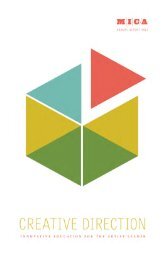art/vision/voice - Maryland Institute College of Art
art/vision/voice - Maryland Institute College of Art
art/vision/voice - Maryland Institute College of Art
You also want an ePaper? Increase the reach of your titles
YUMPU automatically turns print PDFs into web optimized ePapers that Google loves.
120 <strong>art</strong> / <strong>vision</strong> / <strong>voice</strong><br />
tackle. What a nice activity to determine how<br />
students could make the space more<br />
appropriate for their needs. A big mural<br />
painted on paper or canvas and nailed to a<br />
frame that could act as a divider might have<br />
been one solution. Having children engage in<br />
the decoration <strong>of</strong> the space would have been<br />
fun for a group <strong>of</strong> 11–14 year olds who love<br />
lots <strong>of</strong> activity and hands-on fun. It would<br />
have immediately engaged them and integrated<br />
several <strong>art</strong>istic methodologies in the process.<br />
Naming the program “<strong>Art</strong> Club” created an<br />
immediate atmosphere <strong>of</strong> defeat. Many<br />
children this age view <strong>art</strong> as a skill or talent<br />
they do not have and as such become<br />
immediately turned <strong>of</strong>f or frustrated because<br />
they feel they will be called upon to do what<br />
they think they can’t do. Low self-esteem<br />
plagues so many <strong>of</strong> our youth. Perhaps the<br />
students could have been given the<br />
opportunity to name their own “<strong>art</strong>”<br />
gathering—selecting a name based on their<br />
own experiences, their understanding <strong>of</strong> what<br />
they would be doing. P<strong>art</strong>icipants in a<br />
program like this need some ownership <strong>of</strong> the<br />
process, p<strong>art</strong>icularly if it is a stand-alone<br />
program not linked to a youth-serving<br />
organization or a program where the youth do<br />
other things, and “<strong>art</strong>” is just one item on a<br />
menu <strong>of</strong> activities.<br />
Selecting an Age-Appropriate Curriculum<br />
The first project (coat <strong>of</strong> arms) captured the<br />
attention <strong>of</strong> the youth p<strong>art</strong>icipants. It was a<br />
successful project that all students could<br />
p<strong>art</strong>icipate in regardless <strong>of</strong> their <strong>art</strong>istic skill<br />
level, and they seemed to feel comfortable with<br />
the project choice. The disagreement between<br />
the three cap leaders after the initial<br />
project’s success was problematic. The two<br />
female leaders wanted to select a project that<br />
was tactile and “free.” The male cap leader<br />
wanted a two-dimensional drawing skill<br />
activity, thinking that kids needed to learn<br />
traditional <strong>art</strong>-making techniques or the entire<br />
class would not have much value.<br />
Although there was no real consensus among<br />
the leaders, they went with the latter idea, and it<br />
was a disaster! Given the difficulty <strong>of</strong> recruitment<br />
when p<strong>art</strong>icipants thought “<strong>Art</strong> Club” equaled<br />
“<strong>art</strong> skill,” and their initial apprehension about<br />
getting involved, teaching two-dimensional<br />
drawing as a second lesson was a bad idea and<br />
reinforced the students’ initial fears. It had to be<br />
very frustrating for most <strong>of</strong> them.<br />
In such a setting, it’s important to select<br />
projects that have a high probability <strong>of</strong> a<br />
successful outcome, and preferably those in<br />
which youth can immediately see results.<br />
Mural projects and mosaics, although they are<br />
completed over a longer timeframe, also fall<br />
into this category, because as they work<br />
towards a final product, the kids can visualize<br />
the end in the design they create.<br />
cap students may have to concede between<br />
what constitutes a craft project verses an <strong>art</strong><br />
project, and listen to the <strong>voice</strong>s <strong>of</strong> kids who<br />
are trying to guide them to what they want and<br />
like in a class. Oftentimes the expression <strong>of</strong><br />
the p<strong>art</strong>icipants’ “<strong>voice</strong>” can take the form <strong>of</strong> a<br />
disciplinary problem—worse, it could take the<br />
form <strong>of</strong> non-attendance.<br />
It’s helpful to keep in mind, when it comes to<br />
discipline and curriculum selection, that you<br />
can’t discipline a child whom you do not love<br />
or at least have a respectful relationship with.<br />
Many African American students do not feel<br />
loved, respected, or understood by their<br />
teachers. Lack <strong>of</strong> respect is contagious, and<br />
teachers cannot expect children to respect<br />
them if they don’t respect the children. Also,<br />
different children need to learn in different<br />
ways, so if teachers provide an interesting<br />
and diverse <strong>art</strong> curriculum that meets the<br />
interests <strong>of</strong> a wide variety <strong>of</strong> students,<br />
disciplinary problems will <strong>of</strong>ten fade.
















